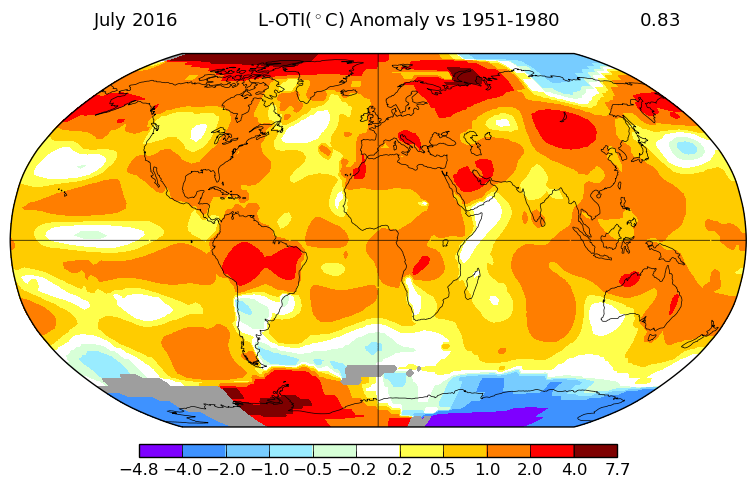SUMMARY
This is AI generated summarization, which may have errors. For context, always refer to the full article.

MANILA, Philippines (UPDATED) – Another month, another record.
July 2016 now has the distinction of being the warmest month recorded, ever since scientists began keeping track of global temperatures, NASA announced Tuesday, August 16.
Scientists from the Goddard Institute for Space Studies (GISS) said that July 2016 was marginally warmer than the warm Julys of 2015, 2011, and 2009 – by a slim 0.1 degrees Celsius.
However, that slim margin over the previous “warmest Julys” was enough to put it at the top of the list of warmest months since record-keeping began in 1880.
“It wasn’t by the widest of margins, but July 2016 was the warmest month since modern record keeping began in 1880,” said GISS Director Gavin Schmidt in a press release.
The year 1880 is the benchmark for global temperature records, since it was the year scientists had data that covered the entire planet, NASA said.

The planet’s geography helps explain why July is usually the warmest month of the year.
Land heats up easier than the oceans. With the presence of more land than sea in the Northern Hemisphere, summer in the planet’s northern half is usually warmer, which in turn raises the planet’s overall temperature for the month of July.
GISS scientists also noted that the Northern Hemisphere – in particular areas near the Arctic – had the “most pronounced” warm temperatures compared to past years.
“It appears almost a certainty that 2016 also will be the warmest year on record,” Schmidt added.
The July 2016 temperature record also continues a 10-month streak of “warmest months” which started in October 2015.
NASA’s analysis is based on data from “6,300 meteorological stations around the world, ship- and buoy-based instruments measuring sea surface temperature, and Antarctic research stations.”
Above-average warmth
The NASA report is echoed by the US National Oceanic and Atmospheric Administration (NOAA), which said on Wednesday, August 17, that July is also the 15th consecutive month to break a monthly heat record.
The NOAA report also found above-average warmth across most of the Earth, with new records observed in parts of Indonesia, southern Asia, and New Zealand.
Scorching temperatures were seen in part of the Gulf region, with several locations across Kuwait experiencing temperatures higher than 113 F during July.
“The highest maximum temperature during July 2016 was recorded in Mitribah, Kuwait when temperatures soared to 126.5 F on July 22,” it said.
In Bahrain, the average temperature of 96.8 F for the month was the nation’s highest July temperature since national records began in 1902.
New Zealand, Spain, and Hong Kong were also unusually warm.
Places that saw near-average or cooler-than-normal temperatures last month included the northwestern United States, eastern Canada, southern South America, southwestern Australia, north central Russia, Kazakhstan, and India.
Ocean temperatures were also at a record high, amid concerns that warming waters are contributing to the spread of coral bleaching worldwide.
NOAA said the 13 highest monthly global ocean temperature departures have all occurred in the past 13 months.
Scientists say the heating trend is being driven by fossil-fuel burning, and is made worse by the ocean warming phenomenon known as El Niño, which came to an end last month.
Heat records were broken even though El Niño has ended, and neither the warming trend of El Niño or the cooler La Niña prevailed across the tropical Pacific Ocean during July 2016.
La Niña is “slightly favored to develop during August–October 2016, with about 55–60% chance of La Niña during the northern hemisphere fall and winter 2016/17,” NOAA said.
But even a break in El Niño, which contributed to the surging global temperatures this year, is not likely to sway 2016 from its track toward becoming the hottest year in the contemporary era for global heat.
NOAA said the first 7 months of the year are the “warmest such period on record at 1.85 F above the 20th century average.”
That is 1/3 of a degree F above the previous record set in 2015. – With reports from Agence France-Presse / Rappler.com
Hotter weather is expected; everyone needs to cool down to keep sane. Click here and get fans, air conditioning units and more to keep cool.
Add a comment
How does this make you feel?
There are no comments yet. Add your comment to start the conversation.